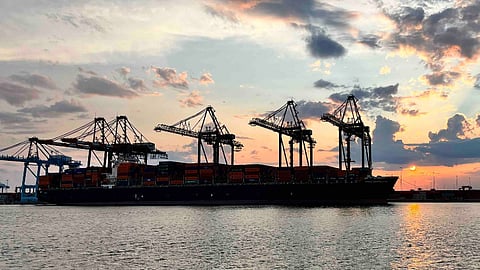Agreement reached to end port strikes across US
Strike action at ports on the US East and Gulf Coast ended on Thursday, October 3, after a new wage agreement was reached – but there remains a backlog of more than 40 ships waiting to offload billions of dollars of cargo, Oslo-based shipping analysis specialist Xeneta said via a press release.
The International Longshoremen’s Association and the United States Maritime Alliance reached a tentative agreement on wages while also extending the Master Contract until January 15, 2025 to allow further negotiations, in particular around automation at ports.
The strike lasted three days and at 05:00 Eastern Time on Friday, October 4, there were 44 ships queuing to enter affected ports and more than 120 en route.
“A prolonged crisis on this scale would have been toxic for global supply chains so the market is breathing a sigh of relief,” said Peter Sand, Xeneta Chief Analyst.
“Closing all ports on the US East Coast and Gulf Coast – even for just three days – comes with severe consequences. We must now wait to see how quickly the returning workers are able and willing to deal with the huge backlog of ships waiting to offload thousands of containers carrying billions of dollars of goods.”
Sand believes the ripple effect of the strike will spread across global supply chains in the weeks to come.
“The dozens of ships delayed on the US East Coast and Gulf Coast will also be late arriving back in the Far East,” said Sand. “This will impact schedules towards the end of this year and possibly into 2025 in the run-up to Lunar New Year at the end of January, which traditionally sees an increase in goods shipped out of the Far East. You cannot miss a scheduled weekly sailing for a ship carrying 15 000 containers and not expect repercussions for carriers and importers.”
Latest data from Xeneta – based on more than 450 million crowdsourced data points – shows shippers have already been hit by increasing freight rates as a direct result of strikes. Average spot rates on the most impacted trade from North Europe to US East Coast stand at US$2,900 per FEU (40-foot container) on October 4, an increase of 58 per cent since the end of August.
The alternative trade from North Europe to the US West Coast has also been impacted with average spot rates increasing 48 per cent in the same period to stand at US$4,450 per FEU.
Sand has warned the market will remain challenging in the weeks and months ahead.
“There has already been a financial impact for shippers through increasing freight rates on Transatlantic trades at a time when markets on other major trades out of the Far East remain elevated due to conflict in the Red Sea,” said Sand.
“It is good news the strike has ended but shippers are not out of the woods just yet. It is only a tentative agreement and automation at ports will remain a major stumbling block. Automation is an issue the two sides have been unable to resolve in over a year of negotiations – now they have just 100 days to reach an agreement otherwise we could see further strike action.”


